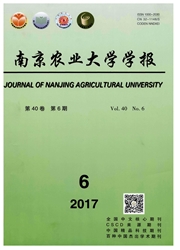

 中文摘要:
中文摘要:
2010年在南京紫金山地区采集小颖羊茅(Festuca parvigluma Steud.)的完整植株和成熟种子,通过染色、分离、特异性基因片段检测等方法探究内生真菌Neotyphodium sinofestucae Chen,Ji et Wang在其体内的分布和种传特性。从植株茎秆、叶鞘、叶片和种子稃片及颖果等部位分别检测和分离到具有禾本科植物内生真菌特征的真菌。同时,从含有内生真菌的种子培育实生苗,并从实生苗中检测和分离到类似的内生真菌。通过对tubB基因片段的PCR扩增和检测,证明分离自小颖羊茅的样品与其实生苗的分离菌株是相同的N.sinofestucae。上述结果表明:N.sinofestucae遍布小颖羊茅植株地上部分,却不进入根部;内生真菌N.sinofestucae能进入种子,通过种子进行垂直传播,与宿主植物长期互利共生。
 英文摘要:
英文摘要:
Plant samples of Festuca parvigluma Steud. were collected in 2010 from the Zijin mountain in Nanjing for exploring characters on endophyte distribution and seed transmission of the endophytic fungus Neotyphodium sinofestucae Chen, Ji et Wang. The endophytic hyphae were detected and isolated from the piths, leaf sheaths, leaf blades,bracts and caryopses. Meanwhile, similar endophytic fungus was also observed and isolated from the seedlings raised from the infected seeds. Fungal strains isolated from the parental and the successive generation of F. parvigluma respectively, were both identified as N. sinofestucae by using morphological characteristics and phylogenetic analysis based on DNA sequences of tubB fragments, indicating its ability of seed transmission within the host plants. N. sinofestucae was found to distribute in the aerial part of host plants while absent in fibrous roots.
 同期刊论文项目
同期刊论文项目
 同项目期刊论文
同项目期刊论文
 A new Epichloё species with interspecific hybrid origins from Poa pratensis ssp. pratensis in Liyang
A new Epichloё species with interspecific hybrid origins from Poa pratensis ssp. pratensis in Liyang Neotyphodium sinicum, from several Roegneria species throughout China, provides insights into the ev
Neotyphodium sinicum, from several Roegneria species throughout China, provides insights into the ev 期刊信息
期刊信息
